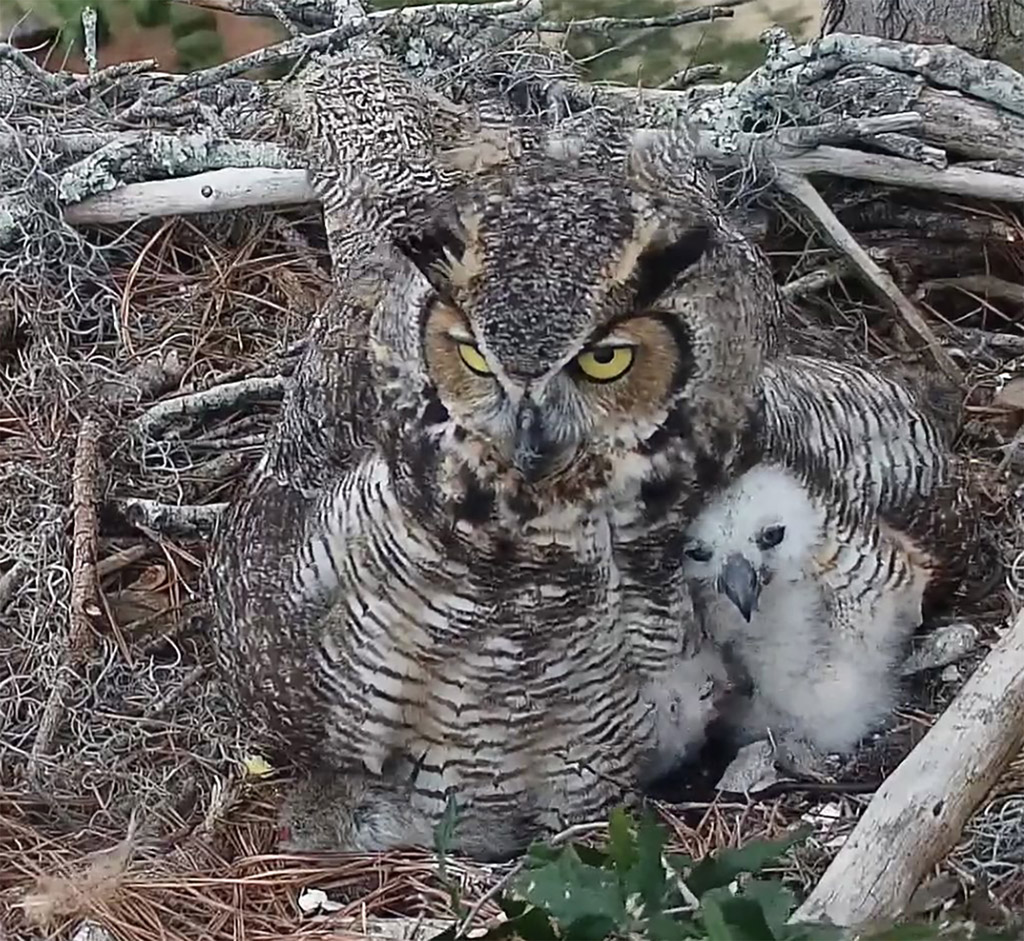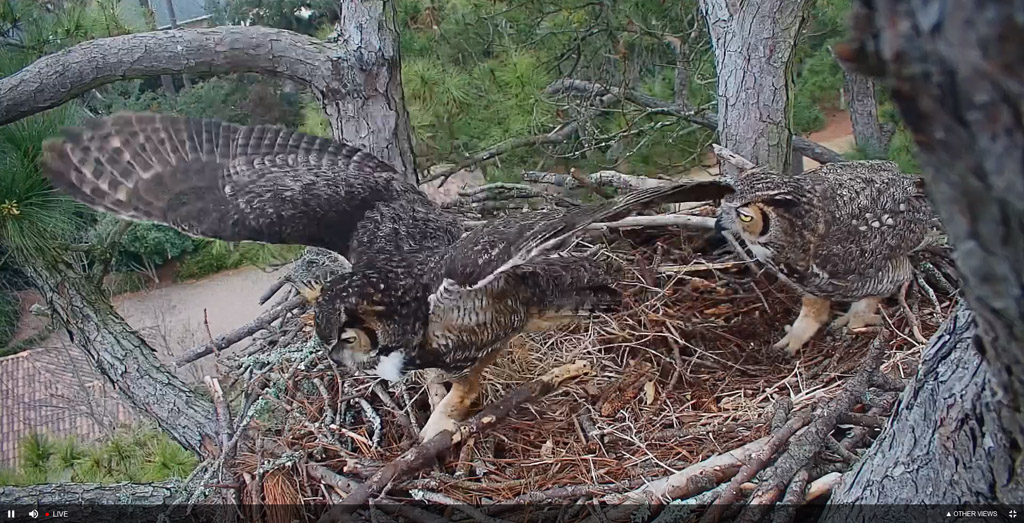With their long, earlike tufts, intimidating yellow-eyed stare, and deep hooting voice, great horned owls are the quintessential owls of storybooks. These fearless and powerful predators, nicknamed Tigers of the Air, thrive at the top of the food chain. They can take down birds and mammals even larger than themselves and, like other top predators, their only real threat is human.
The great horned owl is opportunistic – even aggressive – when it comes to nesting behaviors, typically poaching in a nest 20 to 60 feet above the ground that was built by other large birds, such as hawk, eagle, crow, or heron. A bit lazy, the owls add little or no nest material to the stolen nest except maybe feathers from time to time. This nest-poaching behavior is the reason that Hilton Head Island now has a pair of these world-famous owls.

Bayley and owlet cuddle on a cold morning in February.
But before we get to that, a little back story is interesting:
In 2021, the now-celebrated, live-streaming Hilton Head Island Land Trust (HHILT) Nest was discovered in the wild by Russell Patterson, local attorney. He spotted an eagle in flight and followed it. Eventually the eagle perched in a tree and Patterson saw a female in a nest. He then deduced that there were eggs being incubated.
Patterson contacted the landowner where the tree was located and got permission to mount a camera to observe the entire process. As a result, the Hilton Head eagles became somewhat of a global phenomenon on what is now dubbed the Raptor Cam, with viewers eagerly awaiting the eagle hatchlings, who did finally arrive.
“Our mission at the Land Trust is to preserve and protect our natural habitat as well as significant land on Hilton Head,” said Robin Storey, HHILT treasurer and board member. “Plus, we educate people on why this mission is important to all of us. The local wildlife is part of our human habitat, and they – like us – enjoy our natural habitat. So, it’s important to have balance between the two. The livestream video of the nest helps people understand that balance.”

Joshua and Bayley put on a show for Hilton Head Land & Trust’s Raptor Cam
In 2022, viewers watched two eaglets hatch but, unfortunately, both contracted the avian influenza and died. The eaglets fell out of the nest a day apart. Storey took the first one to the Birds of Prey Avian Clinic outside Charleston, and Patterson took the second one the next day.
While it took the avian clinic staff a while to figure out what was happening, the fact that HHILT was streaming the entire time and had video to share allowed the veterinarians to observe the symptoms and effects of the avian flu.
Last year, though the eagles returned to the nest, they didn’t stay. However, the nest didn’t remain uninhabited. Other birds visited the nest, including the great horned owl poachers, who didn’t stay long. HHILT members believe that last year was likely their “practice season.” After that, some ospreys took it over but didn’t stay either. Then, in September, the same pair of great horned owls returned and began courting and working in the nest.
The Hilton Head Island Land Trust has a tradition of naming nesting pairs after significant people in Hilton Head Island History. The female owl, Bayley, is named in honor of John Bayley of Ballinclough, County Tipperary, Ireland. John Bayley was granted a 48,000-acre barony in 1698, which included Hilton Head Island. This land remained in possession of the Bayley family until roughly 1722, when it was divided into parcels, with many of the boundaries remaining recognizable today.
The male owl is named Joshua, for Gen. Joshua Howell, for whom Fort Howell on Hilton Head Island was named. Gen. Howell was killed during the Siege of Petersburg in 1864. The 32nd U.S. Colored Infantry constructed the fort to protect the nearby Freedmen’s town of Mitchelville. General John G. Foster named the post Fort Howell in honor of the fallen general.
“Our first egg was laid on January 2, and our second egg was on January 6,” Storey said. “They usually lay anywhere from a couple of days apart to five days apart. For the past few months, we’ve watched Bayley do pretty much all the incubation.”
Joshua’s job is to hunt. He goes out and gets the food, brings it to her in the nest, or she goes to him on his roost and gets the food. Meanwhile, Bayley sits anywhere from 28 days to 35 days before they hatch. The average incubation is 33 days.
The nest has welcomed two new members, HH5 and HH6. These names signify that they are the fifth and sixth hatchlings in the history of the Hilton Head Island Land Trust Raptor Cam. HH5 hatched on February 5 at 10:09 p.m., while HH6 made its entrance into the world from its egg at 3 a.m. February 8. While HH5 was captured on camera being fed by Bayley, HH6 was camera-shy early on.
Like eagles, great horned owls mate for life. They also tend to stay in the same territory year after year, which explains why they’ve returned to the HHILT nest. They are a protected species, so their natural life span ranges from 20 to 30 years.
The HHILT operates with the goal to ensure the safety of these and all wildlife. To that end, they remind us to be aware that the rodent poison used in our yards and around the home is harmful to birds that digest the rodents. The HHILT encourages us to abstain from using poison and to make an effort to let the birds be the natural pest controllers they are created to be.
When the owlets are born, they have only a few downy feathers, so for the first week to 10 days, they are blind and not moving around much. The female will stay with them during that time to keep them warm because they don’t have any feathers. They will eat only meat – rodents, squirrel, possums, rabbits and such, which the male provides.
At birth the young weighs 1.22 oz. on average and can gain about 1.2 oz. a day for the first four weeks of life with typical weights in the range of 1.8 or 2.2 pounds by 25 to 29 days for males and females, respectively. Full grown females weigh more than males – 3.5 pounds on average to the male’s 2.7 pounds.
“The owlets will stay in that nest until they start branching out, which is usually five weeks of age,” Storey said. “But even then, they stay in the area close with their parents for up to nine months because they must learn how to do the hunting before they are independent. So, we’ll be able to watch them for quite a while from the raptor cam, which is nice.”
The biggest predator of the owlet while they’re in the nest is another raptor. The owlet can fall prey if mom or dad are gone, or they could fall out of the nest. If the owlets survive, a long productive life is possible.
Next year, if the parents are still together, they’ll come back and have another brood, and viewers can watch them lay new eggs, see the owlets hatching, and watch their great horned owl family grow. In the meantime, perhaps other raptors will visit and begin families of their own.
Beyond the Raptor Cam and protecting the wildlife that thrives on Hilton Head Island, the HHILT focuses its efforts on the preservation of protected properties, which include Fort Howell, the Whooping Crane Pond Conservancy, the Cypress Conservancy, the Northridge tracts, and the Museum Street property.
HHILT corporate sponsors include the Russell Patterson Law Firm, which has been a sponsor since the inception of the Land Trust. Hargray is a valued sponsor that provides the internet to the tree where the nest is. Monster Tree Service, which has done some work for the Land Trust at Fort Howell, is another sponsor.
To watch the Raptor Cam and to learn more, become a member, or to donate to the HHILT, visit HHILandTrust.org.



